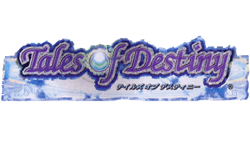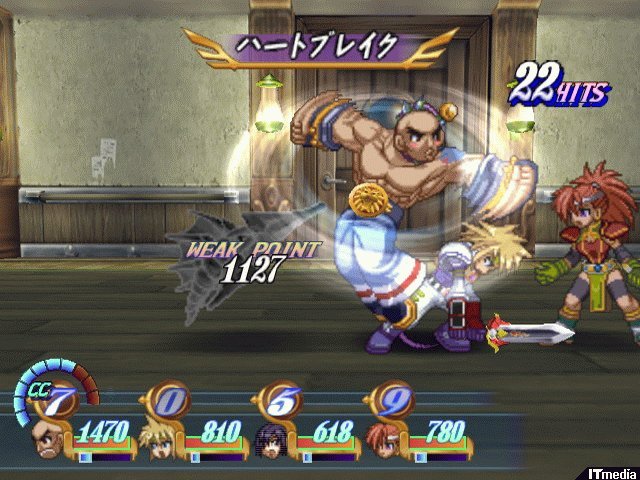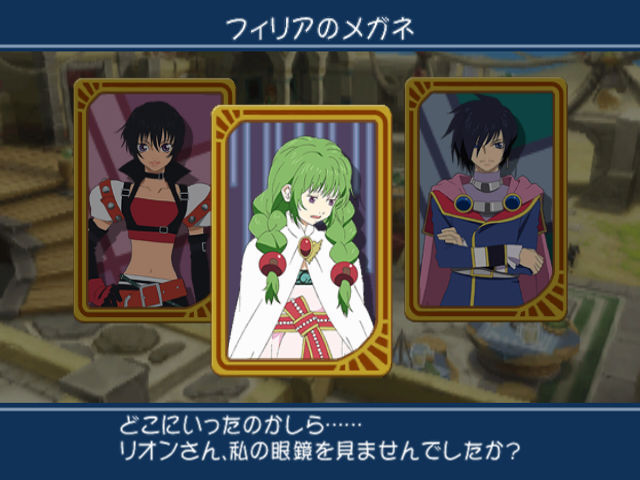|
|

|
PLATFORM
|
PS2
|
BATTLE SYSTEM
|

|
INTERACTION
|

|
ORIGINALITY
|

|
STORY
|

|
MUSIC & SOUND
|

|
VISUALS
|

|
CHALLENGE
|
Easy to Virtually Impossible
|
COMPLETION TIME
|
30 to 50 hours
|
|
OVERALL

|
Click here for scoring definitions
|
|
|
Tales of Destiny was originally released on the PlayStation in 1998 as the second game of the series. Namco is no stranger to remakes, and over 8 years later the game was completely remade and released on the PlayStation2. Instead of relying on a well-known name to milk money out of fans, Tales of Destiny does nothing less than redefine what a "remake" should be. While it is impossible to avoid comparisons to the original, Tales of Destiny should be seen as a full-fledged new game that stands completely on its own merit, as the storyline and characters are the only aspects that remain even remotely similar.
Battle systems have always been an integral part of the Tales series, and Tales of Destiny delivers in this department with a blast. Battles use the familiar Linear Motion Battle system, which is not unlike a 2D fighter game with RPG elements. The action is very frantic and fast-paced, and players will quickly find themselves engaging the enemy with high-hit, impressive combination attacks. Simple button mashing, however, will quickly lead to defeat. Defeating the more challenging enemies requires strategy in picking suitable special attacks, and using them with correct timing.
 Combo insanity
Combo insanity
|
|
If attacks in Tales of Destiny are a bliss of high-hit comboing, it is due to a major change only previously seen in Tales of Rebirth: the absence of MP. In battle, characters instead have a CC (charge capacity) gauge, which is depleted by using attacks and/or skills. Once characters have completed their attack combination (which can continue until CC is drained), it is quickly recharged again. This in effect not only encourages long combo attacks, but also nicely creates a balance between low-level and high-level skills. While high-level skills are more powerful, they also require more CC. Many skills learned very early on in the game are still useful at the end of the game, instead of being obsoleted by late-game skills.
The high speed of action in battles does not even stop with the most powerful spells. The only exception is when a character's unleashes a special attack which can only be activated when a Blast Caliber gauge is full. This gauge is filled during battle when dealing or taking damage (think limit breaks), and can then be unleashed for extremely devastating attacks. All in all, the battle system stays true to its roots while successfully adding fresh ideas.
In terms of control, there is nothing to complain about. Controlling a character's attacks in battle feels easy and natural. Menus are not only simple to use and navigate, but they feature a multitude of options for controlling characters in and out of battle. Fortunately, the AI for non-controlled characters is usually good enough to be left alone in combat, and will not require overt micromanagement.
 Poor Philia has lost her glasses again...
Poor Philia has lost her glasses again...
|
|
Equipping characters in their quest involves at times buying new equipment from shops, but more often they are self-created with the "Rerise" system. If a party is high-leveled enough, and have collected appropriate amounts of lens (dropped by encounters), certain weapons and armor can be improved to the next level. Characters who use Swordians as weapons power them up in a different manner: fighting encounters and leveling up produces "Device Points", which can be used to unlock and enable new features and stat boosts in the Swordians.
A familiar annoyance is that encounters are, in most places, random. This is somewhat alleviated by a colored meter showing when the next encounter will occur, but it still has the potential to become frustrating in dungeons that require backtracking to solve puzzles.
Though it was not his best work, Motoi Sakuraba provided a solid and enjoyable soundtrack for Tales of Destiny. The remake, fortunately, has received an upgrade. The compositions remain the same, but samples have been greatly improved, and the sound quality is on par with modern games. Several new tracks have also found their way into the remake, and these tend to stand out as being particularly good. The audio is further helped out by the rich and excellent voice acting. The majority of cutscenes are voiced, and as is now traditional in the series, there is a huge amount of mostly humorous voiced skits. Both in and out of battle, voices add a great deal to the characters' personalities. People familiar with the original will be pleased to know that the Swordians also talk (a lot!)
Tales of Destiny's story is about people who... well, meet by chance (or destiny?) to follow their destiny (or chance?) The main characters are brought together when they get their hands on Swordians, ancient and powerful sword-like weapons who are actually alive. At its core, the storyline is hardly original, and not much more than the usual "people gather together to fight an ancient evil and save the world." As far as storyline length goes, it is about average, and feels appropriately paced. Far better than the actual storyline is its execution. Quite a few scenes are memorable, and some of them are further enhanced by anime cutscenes. Many scenes are also majorly different from the original PlayStation version, and always for the better. In particular, the questionable motives of a certain party member are now explained much more in detail, and that character can actually be sympathized with. The game's story is not the reason to play it, but it does not hurt the playing experience either, and the occasional well-directed scene can provide added enjoyment.
While at first glance the graphics appear to be pure sprites, they are actually 3D backgrounds mixed in with 2D character sprites. Though nothing comparable to some high-budget, high-profile games, most backgrounds are relatively eye-pleasing and fit the style of the game perfectly. Absolutely no detail gives any hint that this game once existed on older hardware. The most impressive visuals of the game can be found in some of the high-level, way-over-the-top battle animations. Most importantly, however, is that the graphics are consistent throughout the game, and never feel irritating or out of place.
Tales of Destiny, like many others before it, features a selectable difficulty level for battles. However, Tales veterans should be warned that this game is more difficult than most. Normal mode can pose a challenge at times, and Hard mode is far more difficult than other Hard modes seen in the series. Players choosing to fight in Hard mode can expect to get clobbered over and over again by both random encounters and bosses! Finishing the game opens up extra features, one of which is a very difficult bonus dungeon. If that is not enough for the masochists, finishing the game also unlocks even harder modes...
With Tales of Destiny Remake, Namco has once again raised the bar for all other "remakes." The game is not only a very solid production, but nearly every part is polished to the end. Unfortunately, the chances of this game being translated are slim. This may be for the best, as the huge amount of voices in the game would almost certainly be cut from the translation, given Namco's track record. For those who loved the original Tales of Destiny, the choice is simple - look for a way to import this game and start taking Japanese lessons. Those who were disappointed with the shortcomings in the original will most likely also want to hunt down this game. For those who have never played the original, Tales of Destiny Remake is a solid game that can be enjoyed as a fully new experience.
Review Archives
|









